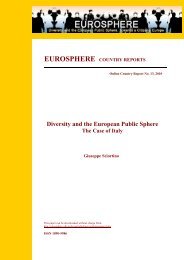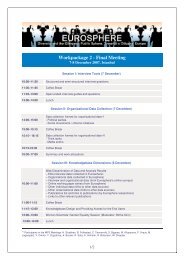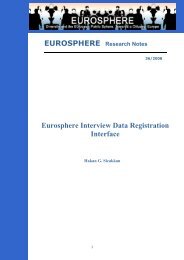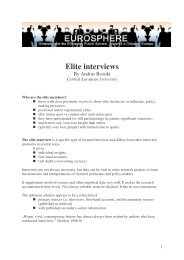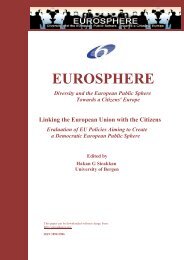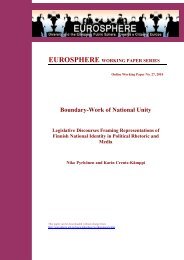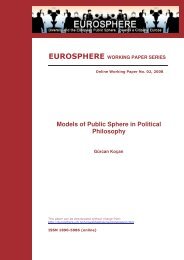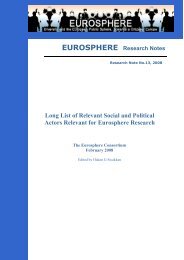Migrants, Minorities, Belongings and Citizenship. Glocalization and ...
Migrants, Minorities, Belongings and Citizenship. Glocalization and ...
Migrants, Minorities, Belongings and Citizenship. Glocalization and ...
Create successful ePaper yourself
Turn your PDF publications into a flip-book with our unique Google optimized e-Paper software.
2.2.7. Mobility of Minds – Psychic/Mental Mobility<br />
Mobility of minds is closely related with the ontological <strong>and</strong> theoretical approaches in this<br />
study. Mobility of minds – or psychic/mental mobility – is defined as individuals’ ability to<br />
imagine themselves in other times <strong>and</strong> places <strong>and</strong>/or as belonging to other groups. The<br />
most important aspect of the concept is its focus on individuals’ ability to move between<br />
different references of identification. The respondents were asked to respond to multipleitem<br />
batteries measuring their ability to imagine themselves as belonging to other social<br />
groups, places <strong>and</strong> times. The method of measurement comprised, among other things,<br />
a comparison of “what respondents want for themselves” <strong>and</strong> “how they respond to<br />
others’ dem<strong>and</strong>s which are basically the same as the respondents’ own dem<strong>and</strong>s”. There<br />
were also items that comprised direct questions on imagined times, places, <strong>and</strong> roles.<br />
Most of the items measuring respondents’ mental mobility were designed along a 5-point<br />
Likert scale.<br />
Some of the items were designed as “qualitative questions” <strong>and</strong> these were later<br />
interpreted <strong>and</strong> quantified with respect to st<strong>and</strong>ard criteria, taking also into consideration<br />
the respondents’ general attitudes <strong>and</strong> body languages during the interviews. The field<br />
researchers’ evaluations <strong>and</strong> the raw data material were sent to the coordinator, who<br />
coded the after a total evaluation of respondents with respect to their answers to the<br />
respective questionnaire items <strong>and</strong> their responses during the qualitative interviews.<br />
Since we do not have the qualitative report for the three respondents from Denmark,<br />
only the data obtained with the questionnaire were used for the respondents residing in<br />
this country.<br />
Table 9. Components of Mind-Mobility Patterns<br />
Dimension<br />
1 2<br />
Mobility of Mind: Time ,786 -,579<br />
Mobility of Mind: Place ,941 -,014<br />
Mobility of Mind: Belonging ,767 ,612<br />
Explained variance % 69,75 23,68<br />
Application of the CATPCA-procedure to the respondents’ mobility scores resulted in two<br />
dimensions, which are shown in Table 9. The first dimension is unipolar. It can be<br />
interpreted as measuring the degree of general mind-mobility of the respondents<br />
between different belonging references such as time (past, present <strong>and</strong> future), place<br />
(birth place, residence place, national territory, visited places, or places respondents<br />
81



